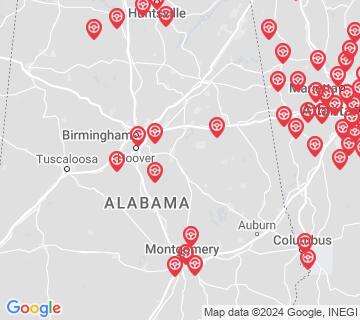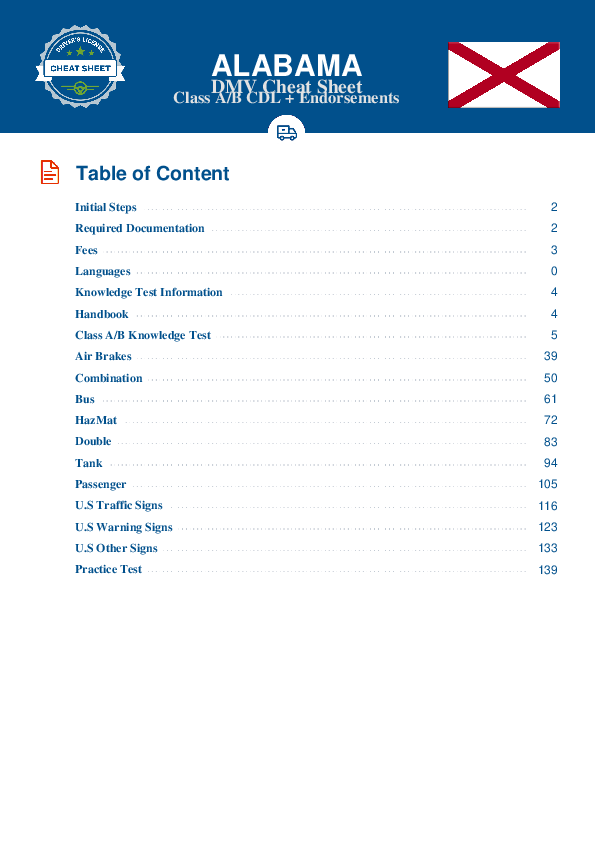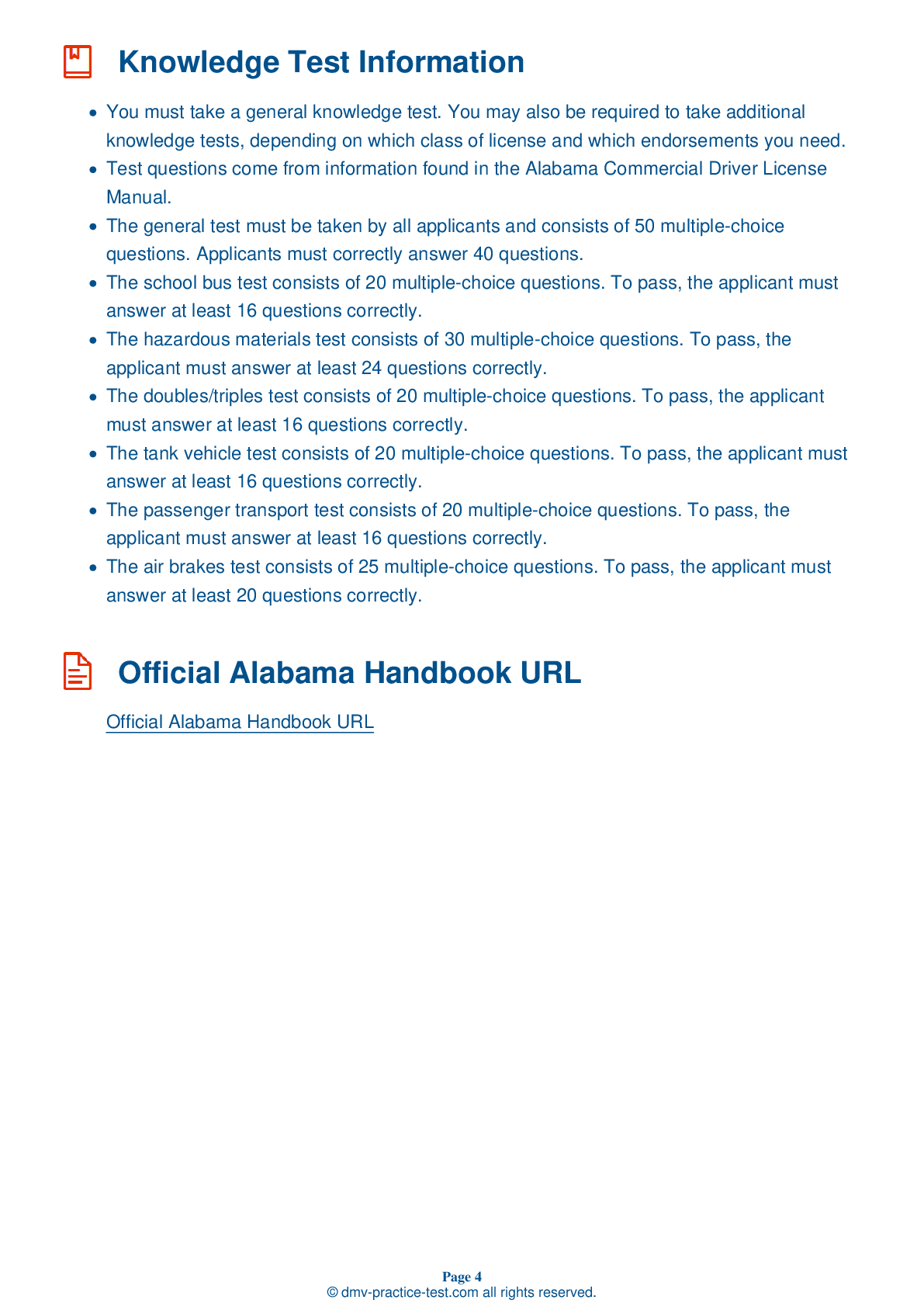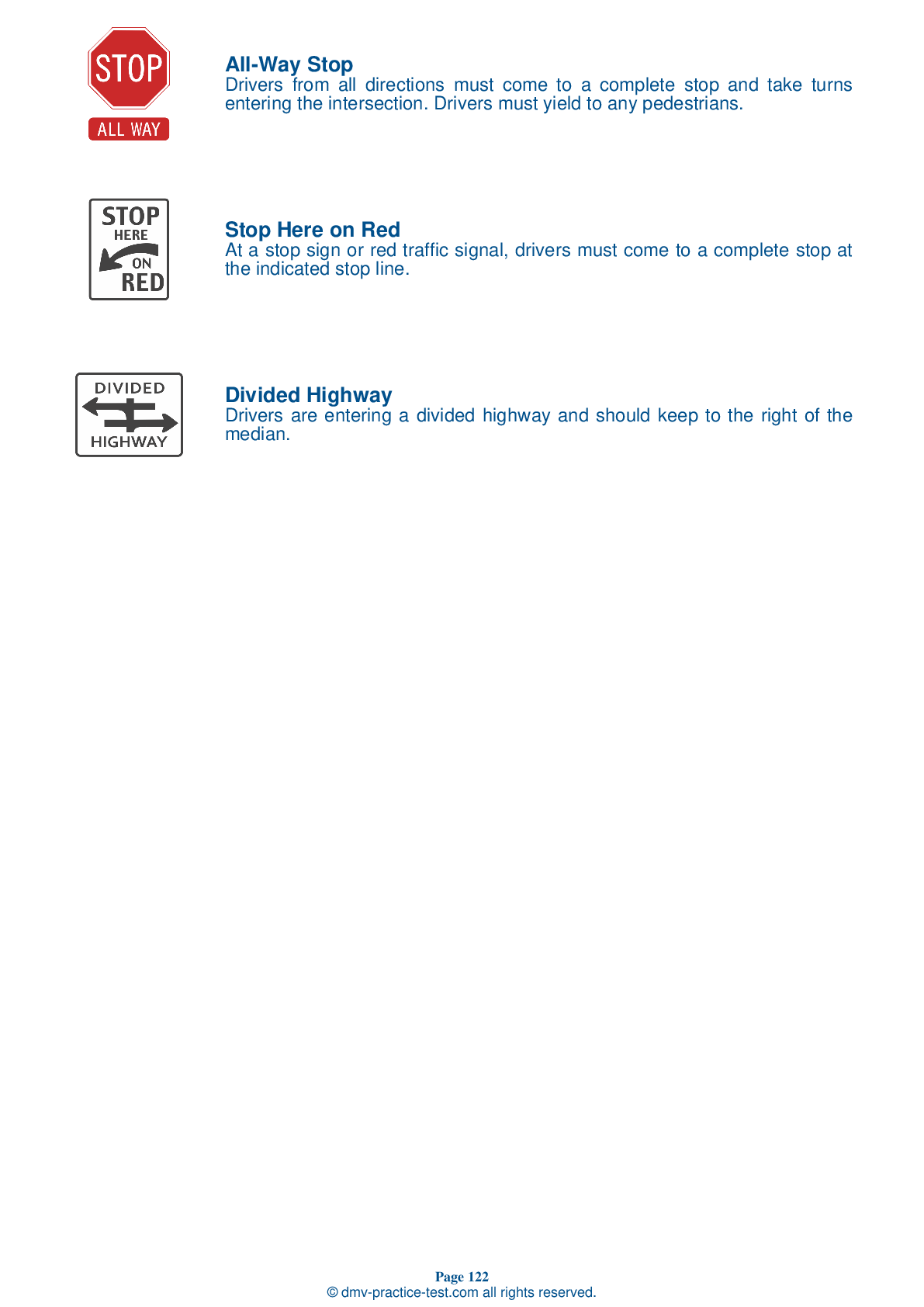Double #2
Double Triple Test | Alabama 2025 #2 Page 3 of 3
Train for FREE with our Alabama CDL double triple practice test online. The official exam test consists of several obligatory parts, with all of them checking your knowledge of different blocks of road rules. If you need to obtain a AL CDL double triple license in 2025, practice as much as possible. Free sample tests published on our website will help you check and improve your knowledge and boost your grades. Please bear in mind that DMV requirements may vary from state to state.
20
16
20
15 . Dollies equipped with ABS are required to have malfunction lamps located where?
On the top
A dolly equipped with an Anti-Lock Braking System (ABS) is required to have a yellow malfunction lamp located on its left side.
16 . Lights that indicate that anti-lock brakes are not working are:
Vehicles equipped with Anti-Lock Braking Systems (ABS) have yellow malfunction lights to indicate issues in the braking system.
17 . After coupling, there should be ____ between the upper and lower fifth wheel.
Three inches of space
Before a trip, be sure to inspect all couplings. There should be no space between the upper and lower fifth wheel.
18 . Before beginning downhill, you should:
Rely only on braking to reduce your speed.
On a steep downgrade, you must use the engine's braking effect as your primary method of speed control. Be sure to decelerate and downshift appropriately before beginning to drive down the hill. Relying too heavily on the brakes may cause them to overheat and fade, becoming less effective.
19 . When inspecting the windshield before a trip, a person should do all the following, except:
When inspecting your windshield, you should look for cracks or other problems that could interfere with your ability to clearly see the road. The windshield wiper arms should be checked for proper spring tension. The wiper blades should be checked for damage, stiff rubber, and improper securement.
20 . Which of the following is not an example of a driving hazard?
An ice cream truck
Passing an accident scene can be hazardous because the people involved in the accident may not be watching traffic, and the scene itself may distract other passing drivers. Ice cream trucks can create hazardous conditions because they attract children who may not pay attention to nearby vehicles. Shoppers near the roadway are often paying attention to stores, not passing traffic.
Search the best driving school in your neighbourhood
2025 Alabama | Frequently Asked Questions
To secure a CDL Doubles/Triples endorsement in Alabama, you must already possess a valid commercial driver's license (CDL). You'll then need to pass the Doubles and Triples Endorsement Knowledge Test. This test covers topics such as coupling and uncoupling, inspecting doubles and triples, and the proper procedures for towing double/triple trailers.
To obtain a CDL Doubles/Triples license, you must first have a valid commercial driver's license (CDL). Next, you'll need to pass the Doubles/Triples Endorsement Knowledge Test. This test covers areas such as coupling and uncoupling, inspecting doubles and triples, and correct towing procedures. Finally, pay the necessary fees to add the endorsement to your CDL.
While Alabama doesn't mandate specialized training for a CDL Doubles/Triples endorsement, it's recommended to study the Doubles/Triples section in the CDL manual thoroughly. This will prepare you for the written knowledge test at your local DMV. Practical experience driving such vehicles can also be beneficial, but it's not a legal requirement.
Yes, to obtain a CDL Doubles/Triples endorsement, you must pass the Doubles/Triples Endorsement Knowledge Test. This written test covers specific areas related to driving double and triple trailers, such as coupling and uncoupling, inspecting doubles and triples, and the correct procedures for towing these types of trailers.
The CDL Doubles/Triples endorsement test is a written knowledge test, not a skills test. It covers topics like coupling and uncoupling, inspecting doubles and triples, and correct towing procedures. However, practical skills like maneuvering such vehicles safely are important to learn during training, even though they are not directly tested during the endorsement exam.
No, it's not permissible to operate double/triple trailers without a valid CDL Doubles/Triples endorsement in Alabama. This endorsement is required by law to ensure that drivers have the necessary knowledge and skills to operate these types of vehicles safely. Operating without the proper endorsement can result in fines and penalties.
You can add the CDL Doubles/Triples endorsement to your existing Commercial Driver's License. You don't need to initiate a completely new application. However, you will need to pass the Doubles/Triples Endorsement Knowledge Test and pay any associated fees to obtain this endorsement. Always check with your local DMV for specific procedures and requirements.
Yes, there are limitations for drivers with a CDL Doubles/Triples endorsement. These drivers can only operate vehicles that are specifically designed for double or triple trailers. They can't exceed the weight limits set by federal and state laws, and they must comply with hours of service regulations to prevent fatigue-related accidents. Additionally, specific routes may be restricted for these vehicles.
In Alabama, the maximum legal weight for a double or triple trailer setup is 80,000 pounds, depending on the trailer's axle configuration. The maximum length for any one trailer is 53 feet, but the combined length of all trailers can't exceed 65 feet. Violating these restrictions may result in penalties or fines.
Yes, drivers with a CDL Doubles/Triples endorsement must follow specific safety guidelines. These include conducting pre-trip inspections, understanding how to couple and uncouple correctly, and knowing how to handle the high rollover risk associated with these trailers. They must also ensure proper weight distribution in trailers and follow the rules for maintaining safe following distances. Compliance with all federal and state regulations is mandatory.




